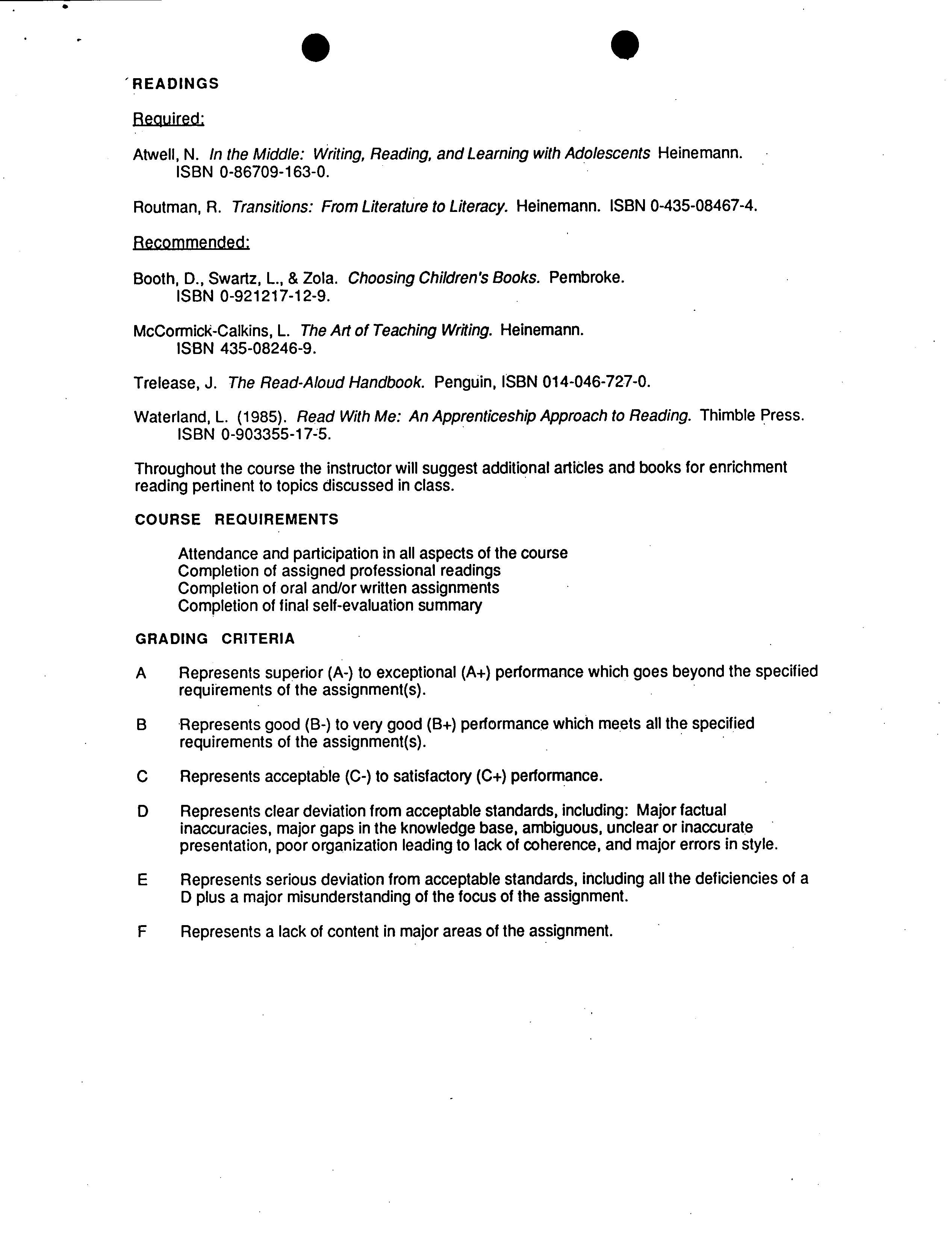• ?
S
SIMON FRASER UNIVERSITY ?
Faculty of Education
EDUCATION 385-4
?
SPECIAL TOPICS: WHOLE LANGUAGE
Summer Intersession, 1989
?
Instructor: ?
Pat Holborn
(May 8—June 16)
?
Telephone: ?
291-4770 (office)
Wednesday/Friday
?
931-7282 (home)
1:00 - 4:50 p.m.
Location: MPX 7610
Whole language in its essence goes beyond the simple
delineation of a series of teaching strategies to describe a shift in
the way in which teachers think about and practise their art."
(Sharon Rich)
PREREQUISITE:
Educ. 401/402 or equivalent.
PURPOSES
The purposes of this course are to help beginning and experienced te
-
achers a) understand the
theoretical foundations on which whole language instruction is based, and b) develop practical
strategies for a whole language instruction approach throughout the classroom curriculum.
GOALS
Students in this course will:
1.
understand the theoretical. and research foundations of the whole language approach;
2.
become familiar with a variety of instructional strategies for implementing a whole language•
approach;
3.
become familiar with strategies for assessing children's language and evaluating individual
progress in a whole language program;
4.
clarify personal beliefs about the teacher's role in a whole language program;
5.
be able to articulate a rationale for using a whole language approach in their own classrooms,
supported with examples from current educational literature and classroom practices.
CONTENT OVERVIEW
Week 1:
Introduction to Whole Language
Week 2:
Developing Meaning through Oral Language
Week 3:
Developing Meaning through Reading
Week 4:
Developing Meaning through Writing
Week 5:
Designing an Integrated Whole Language Program
Week 6:
Evaluation in Whole Language
FORMAT
The course addresses both theories of whole language development and instruction and the
more practical, day-to-day aspects of teaching using a whole language approach. Therefore
classes will include a variety of learning opportunities such as lectures, class discussions, small-
group tasks, experiential learning activities and student presentations.
During the course students will be asked to participate in activities which model whole language
teaching strategies. Participants are encouraged to study these experiences from the viewpoint
of learners as well as teachers.
S ?
.
READINGS
Required:
Atwell, N. In the Middle: Writing, Reading, and Learning with Adolescents
Heinemann.
ISBN 0-86709-163-0.
Routman, R.
Transitions: From Literature to Literacy.
Heinemann. ISBN 0-435-08467-4.
Recommended:
Booth, D., Swartz, L., & Zola.
Choosing Children's Books.
Pembroke.
ISBN 0-921217-12-9.
McCormick-Calkins, L.
The Art of Teaching Writing.
Heinemann.
ISBN 435-08246-9.
Trelease, J.
The Read-Aloud Handbook.
Penguin, ISBN 014-046-727-0.
Waterland, L. (1985). Read With Me: An Apprenticeship Approach to Reading.
Thimble Press.
ISBN 0-903355-17-5.
Throughout the course the instructor will suggest additional articles and books for enrichment
reading pertinent to topics discussed in class.
COURSE REQUIREMENTS
Attendance and participation in all aspects of the course
Completion of assigned professional readings
Completion of oral and/or written assignments
Completion of final self-evaluation summary
GRADING CRITERIA
A ?
Represents superior (A-) to exceptional (A+) performance which goes beyond the specified
requirements of the assignment(s).
B ?
Represents good (B-) to very good (B+) performance which meets all the specified
requirements of the assignment(s).
C
?
Represents acceptable (C-) to satisfactory (C+) performance.
0
?
Represents clear deviation from acceptable standards, including: Major factual
inaccuracies, major gaps in the knowledge base, ambiguous, unclear or inaccurate
presentation, poor organization leading to lack of coherence, and major errors in style.
E ?
Represents serious deviation from acceptable standards, including all the deficiencies of a
D plus a major misunderstanding of the focus of the assignment.
F
?
Represents a lack of content in major areas of the assignment.


